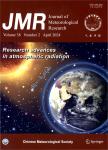Accurate Shortwave Radiation Simulation with a Two-Layer Aerosol Model in Xinjiang Region
作者机构:School of Tourism&Research Institute of Human GeographyXi’an International Studies UniversityXi’an 710128 Center for Silk Road and Eurasian Civilization StudiesXi’an International Studies UniversityXi’an 710128 College of Environmental Science and EngineeringDonghua UniversityShanghai 201620 Shanghai Meteorological ServiceShanghai 200030 Shanghai Key Laboratory of Meteorology and HealthShanghai 200030 Taklimakan Desert Meteorology Field Experiment Station of China Meteorological AdministrationInstitute of Desert MeteorologyUrumqi 830002 Xinjiang Climate CentreXinjiang Meteorological ServiceUrumqi 830002
出 版 物:《Journal of Meteorological Research》 (气象学报(英文版))
年 卷 期:2024年第38卷第1期
页 面:69-87页
核心收录:
学科分类:080703[工学-动力机械及工程] 07[理学] 070601[理学-气象学] 08[工学] 0807[工学-动力工程及工程热物理] 0706[理学-大气科学]
基 金:Science and Technology Planning Program of Xinjiang(2022E01047) National Natural Science Foundation of China(42030612 and 41905131) Scientific Research Program Funded by Education Department of Shaanxi Provincial Government(23JK0625) Natural Science Basic Research Program of Shaanxi Province(2021JQ-768) Social Science Planning Fund Program of Xi’an City(23JX150)
主 题:downward surface shortwave radiation(DSSR) aerosol vertical distribution Clouds and the Earth’s Radiant Energy System(CERES) Santa Barbara Discrete Atmospheric Radiative Transfer(SBDART) Xinjiang
摘 要:To harness the rich solar energy resources in Xinjiang Region of Northwest China,this study tries to address the issue of lack of downward surface shortwave radiation(DSSR)observations and the need to improve the accuracy of satellite retrieval and numerical simulation of DSSR under varied sky and meteorological conditions.(1)A two-layer aerosol model specific to Xinjiang was developed to capture the vertical distributions of aerosols based on multiple data sources including lidar,GPS sounding,ground meteorological observations,and profiles from the ECMWF reanalysis version 5(ERA5)*** results show that the ERA5/PBLH(planetary boundary layer height)and ERA5/ALH(aerosol layer height)could be used to establish the two-layer aerosol model and characterize the vertical distribution of aerosols in Xinjiang Region.(2)Using the Santa Barbara Discrete Atmospheric Radiative Transfer(SBDART)model,a localized inverse model of clear-sky DSSR was *** parameter adjustment and using the optimal combination of input parameters for DSSR simulation together with the two-layer aerosol model,the model-simulated DSSR(DSSRSBD)under clear-sky conditions improved significantly compared to the initial results,with all fitting indices greatly improved.(3)In addition,the study demonstrated that the impact of the two-layer aerosol model on DSSR was more pronounced under dust conditions than clear-sky conditions.(4)Using the localized clear-sky DSSR inversion model and its required parameters,simulations were also conducted to capture the spatiotemporal distribution of DSSR under clear-sky conditions in Xinjiang from 2017 to *** annual average DSSR_(SBD)under clear-sky conditions in Xinjiang during 2017–2019 was 606.78 W m^(-2),while DSSR from CERES(DSSR_(CER))under the same conditions was generally higher(703.95 W m^(-2)).(5)It is found that satellite remote sensing products experienced data loss in high-altitude snow areas,where numerical simulation technology could ser



